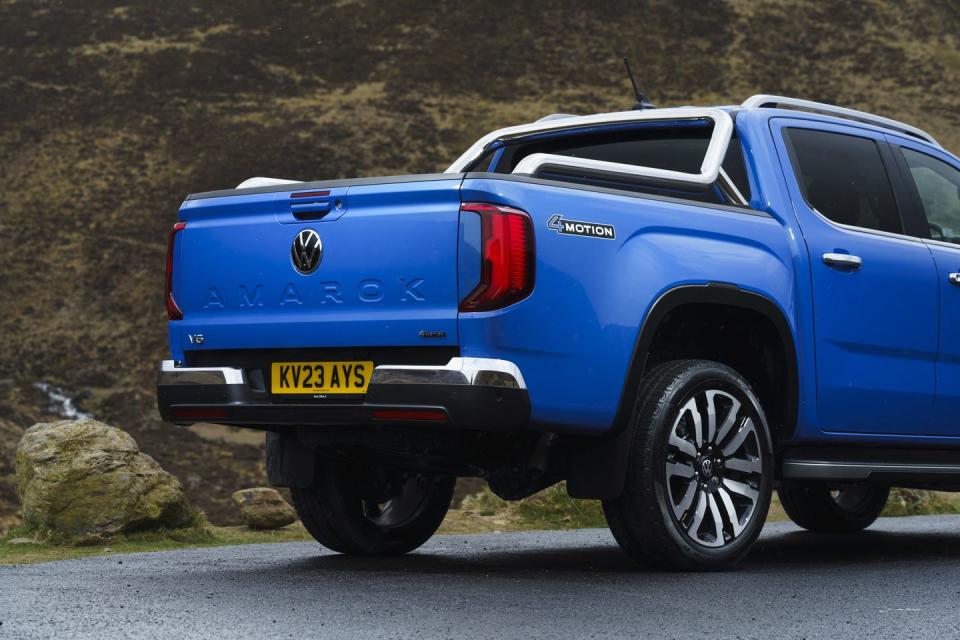2024 Volkswagen Amarok Pickup Is a Cloned Ranger

We love collaborations between unrelated automakers, and the Volkswagen Amarok is a fine example. This mid-size pickup is built in South Africa and sold in many parts of the world, although not in the U.S. While the Amarok is based on the Ford Ranger, every exterior body panel is different, and you don't need to squint too hard to see what lurks underneath.
Volkswagen itself engineered and built the first-generation Amarok. But the second-gen version, launched last year, is part of a wider collaboration between Ford and Volkswagen to jointly develop light vans and trucks. The Amarok shares its ladder-frame chassis, suspension, and powerplants with the Ranger, but is priced and positioned above it.
A single-cab Amarok is offered in some markets, but only the double cab is sold in Europe, where we drove an Amarok (in England). The engine lineup is heavily biased toward diesels. A turbocharged 2.3-liter EcoBoost gas engine is offered in some places, but not in Europe. The base powertrain is a 2.0-liter four-cylinder turbo-diesel making 168 horsepower and mated to a six-speed manual gearbox. Above this, a twin-turbocharged version of the same engine increases power to 202 horses and gets a 10-speed automatic transmission as standard. At the top of the range is a 237-hp turbocharged 3.0-liter V-6 diesel, which is actually the venerable JLR/Ford/Peugeot engine that powered the last-gen Range Rover Td6. All European versions have four-wheel drive and a low-range transfer case, with the 3.0-liter engine also getting an electronically locking rear differential.

Switchgear geeks will have fun in the Amarok's cabin figuring out which partner has supplied the various components. Although the dashboard is unique to the Amarok, Volkswagen's designers have come up with a design that's very similar to Ford's, as both trucks use a large portrait-orientated touchscreen between two chunky air vents. The Amarok gets plusher cabin materials including soft-touch panels on the doors. Light switches, column stalks, and the gear selector all are Ford parts, but the Amarok has a Volkswagen steering wheel and a new circular controller for the different powertrain modes. The Amarok also loses the Ranger's physical heating controls, instead managing temperature and ventilation through the touchscreen.
The Amarok we drove represented the midrange Style trim and had the twin-turbo 2.0-liter diesel. Despite being a ways short of the apex of the lineup, our truck still cost roughly the equivalent of $64,700 (including VAT charges), which is nearly $10,000 less than the most expensive 3.0-liter Aventura model. (For context, those U.K. prices are about $4000 higher than the equivalent Ford Ranger in both cases.) As one would hope for that money, equipment levels are good, with the Style trim getting power seats, a 360-degree camera system, adaptive LED headlights that can alter their pattern to not blind oncoming drivers, and adaptive cruise control with a lane-keeping function.
The driving experience feels very similar to that of the Ranger. When the truck is running unladen, the Amarok's rear leaf springs give a lumpy ride quality over all but the smoothest surfaces, although the dampers work efficiently to prevent unwanted secondary motions. Adding a couple of hundred pounds of bagged gravel to the bed—far short of the Style model's maximum payload capacity of up to 2377 pounds—reduced the choppiness but also caused the Amarok to be more easily thrown off its line by larger bumps. Despite the busy suspension, refinement is excellent for a pickup, as the Amarok cruises at highway speeds with minimal wind or road noise, and the seating position proved comfortable for hours at a time.
The steering is accurate and slop-free, but our truck came wearing mud- and snow-rated Goodyear Wrangler tires that could deliver only limited grip on cold, wet asphalt. Often very limited—fortunately, the Amarok's long 128.7-inch wheelbase means the loss of rear-wheel traction in tight corners tended to result in graceful slow-motion slides. Selecting four-wheel drive changed the handling balance to understeer but delivered superior traction. While we didn't do any towing, Volkswagen claims the Amarok can tug up to 7721-pounds.
The Amarok's twin-turbo diesel is happiest in the lower reaches of its rev range, where the automatic gearbox prefers to keep it. The torque peak of 368 lb-ft is available at just 1750 rpm, and the tallness of the transmission's upper ratios means the engine can cruise at 70 mph without going past that point. Requests for harder acceleration tend to bring multiple downshifts as the transmission juggles its ratios, the engine growing louder and less willing when pushed harder. Despite a digital tachometer marked to 6000 rpm, the Amarok's engine meets its limiter at 4500 rpm and won't even go there unless you manually control the transmission. Left in Drive, it always shifted before 4000 rpm, even when activating its kick-down switch. Volkswagen claims a 10.5-second run to 62 mph and a 112-mph top speed.

Of course, diesel does have some significant benefits over gas when it comes to fuel economy. Driven hard and partially laden, the Amarok returned the equivalent of 22 mpg. Under gentler use, we saw 25 mpg. In Europe, where a gallon of diesel currently costs $7.50 in most countries, mileage is far more important than performance.
We liked the first-generation Amarok when we drove it back in 2018, and we regretted that it would not be brought to the U.S.—at the time, it would have felt fresh and different compared with similarly sized rivals. But the new version has lost the distinction of going its own way and become, in essence, a posher and plusher version of the Ford Ranger. The new Amarok is a likable, classy truck, but even if it were given a different engine and tweaked for American tastes, it wouldn't be original enough to make a case for itself in the States.
You Might Also Like

 Yahoo Autos
Yahoo Autos 